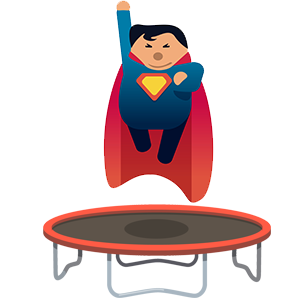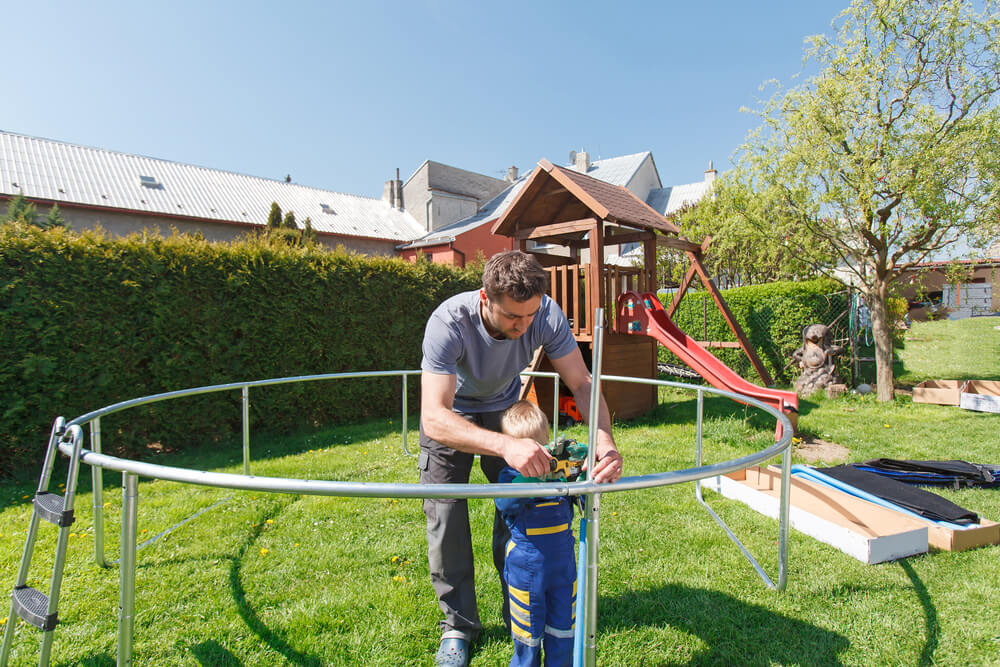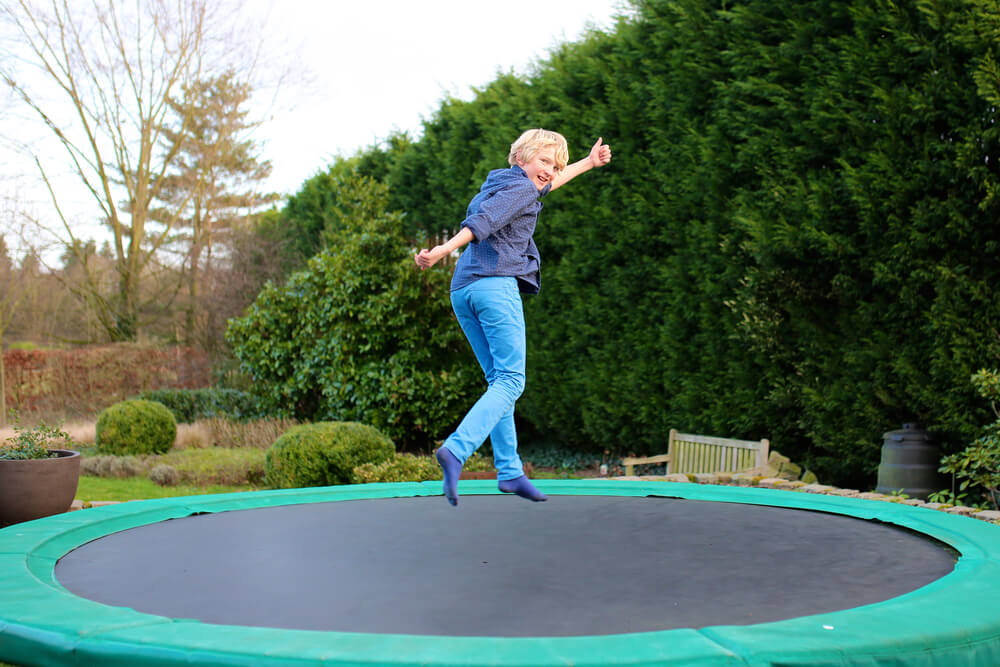Hello there! I’m Shmulik Dorinbaum, the owner of TrampolineFLight, a blog dedicated to all things trampoline. Today, I want to talk about a question that has been bouncing around in my mind (pun intended) – Are trampolines bad for your knees?
As someone who enjoys trampolining and promotes its benefits, I believe it’s crucial to address this concern. After all, we all want to keep in shape while having fun and, most importantly, without injuring ourselves.
In this blog post, we will dive into the mechanics of jumping and landing, dissect common beliefs and myths, and provide scientific studies and expert opinions on the subject. We’ll also share some tips for using your trampoline safely, exercises to strengthen your knees, and alternatives to trampolining that are easy on the knees.
The goal is to provide you, dear homeowners, with relevant, reliable, and helpful content so you can enjoy your trampoline while keeping your knees healthy. After all, who doesn’t want to have a good time bouncing around in their backyard?
Key Takeaways:
- Understand the impact of trampolining on knee health.
- Learn tips and exercises to protect your knees while using a trampoline.
- Discover alternative exercises that are gentle on the knees.
So, without further ado, let’s jump right into it!
The Mechanics of Jumping
Jumping on a trampoline might seem simple, but there’s actually a lot going on in your body when you do it. Let’s break it down:
Impact on the Knees During Jumping and Landing
When you jump, your legs exert force to push you off the trampoline. As you land back on it, the trampoline surface absorbs some of the impact, which is less harsh on your knees compared to landing on a hard surface. However, your knees still absorb a significant amount of force, especially if you land with straight legs or improper technique.
This is why it’s so important to use proper technique when jumping and landing. You want to land softly, with your knees slightly bent, to absorb some of the impact and protect your joints.
Are Trampolines Really Bad for Your Knees?
There’s a common belief that trampolines are bad for your knees, but is it really true? The answer is: it depends.
Common Beliefs and Myths
One of the common myths is that trampolining is bad for your knees because it puts a lot of stress on them. While it’s true that your knees absorb some impact when you land, the trampoline surface actually absorbs a significant amount of it, making it gentler on your joints than landing on a hard surface.
Another myth is that trampolining is only suitable for young people with healthy knees. However, many older adults and people with previous knee injuries have found trampolining to be a fun and effective way to stay in shape without aggravating their knee problems.
Scientific Studies and Expert Opinions
In reality, the impact of trampolining on your knees can vary depending on several factors, including your technique, the condition of your knees, and how you use the trampoline.
For example, a study published in the National Library of Medicine found that trampolining can actually be beneficial for your knee joints if done correctly. The study concluded that trampolining could be used as a rehabilitation exercise for people with knee osteoarthritis.
However, it’s important to note that if you have pre-existing knee issues or are prone to injuries, you should consult a healthcare professional before starting any new exercise regimen, including trampolining.
In the next section, we’ll dive into a case study of long-term trampoline users and analyze the effects on their knee health over time. Stay tuned!
Case Study: Long-Term Trampoline Users
Let’s take a look at the experiences of long-term trampoline users and how their knee health has been affected over time.
Jane’s Experience
Jane, a 45-year-old mother of two, has been using a trampoline for exercise for over 10 years. She started trampolining as a way to stay active and have fun with her kids. Over the years, she noticed that her knee pain, which she initially attributed to aging, actually improved.
She believes that the low-impact nature of trampolining, combined with the strength training exercises she incorporated into her routine, helped strengthen her knee muscles and alleviate her pain.
Mark’s Experience
On the other hand, Mark, a 50-year-old avid runner, started using a trampoline as a way to reduce the impact on his knees while still getting a good cardiovascular workout.
However, he noticed that his knee pain worsened after intense trampolining sessions, especially when he tried to do high jumps and tricks. After consulting with a healthcare professional, he learned that his technique was incorrect, causing unnecessary stress on his knees. After adjusting his technique and intensity, he was able to enjoy trampolining without any pain.
Tips for Safe Trampoline Use
As we can see from the case studies above, using proper technique and being mindful of your body’s signals are crucial for safe trampoline use. Here are some tips to help you protect your knees while using a trampoline:
Proper Jumping Technique
- Land softly with your knees slightly bent to absorb some of the impact.
- Keep your core engaged and maintain a straight posture.
- Avoid locking your knees or landing with straight legs.
Use Supportive Footwear
Wearing shoes with good arch support and cushioning can help reduce the impact on your knees. Avoid wearing shoes with hard soles or going barefoot.
Regular Maintenance
Make sure to regularly check your trampoline for any signs of wear and tear, such as frayed springs or a sagging mat. A well-maintained trampoline will provide better support and reduce the impact on your joints.
Listen to Your Body
If you feel any pain or discomfort while trampolining, stop immediately and consult a healthcare professional. It’s better to be safe than sorry!
In the next section, we will discuss exercises to strengthen your knees, the role of shoe wear, and when to take a break from trampolining. Keep reading!
Exercises to Strengthen Knees
Strengthening the muscles around your knees can help provide more support and reduce the impact on your knee joints. Here are some exercises that can help strengthen your knees:
- Leg Raises: Lie flat on your back and slowly lift one leg at a time, keeping it straight. Repeat 10 times on each leg.
- Hamstring Curls: Stand up straight and hold onto a chair for support. Slowly bend one knee, bringing your heel towards your buttocks. Repeat 10 times on each leg.
- Wall Squats: Stand with your back against a wall and your feet shoulder-width apart. Slowly slide down the wall until your knees are bent at a 90-degree angle. Hold for 10 seconds, then slowly slide back up. Repeat 10 times.
- Step-Ups: Using a step or a low stool, step up with one foot, followed by the other, then step back down. Repeat 10 times on each leg.
Remember to consult a healthcare professional before starting any new exercise regimen.
The Importance of Regular Maintenance
As mentioned earlier, it’s crucial to regularly maintain your trampoline to ensure it provides proper support and minimizes the impact on your knees. Check for frayed springs, a sagging mat, and any other signs of wear and tear. If you notice any issues, make sure to address them immediately.
When to Take a Break
It’s important to listen to your body and take breaks when needed. If you feel any pain, discomfort, or fatigue while trampolining, it’s a sign that you should stop and rest. It’s better to take a short break and resume later than to push through and risk injuring yourself.
Alternatives to Trampolining
If you find that trampolining is not suitable for your knees, there are plenty of other low-impact exercises that can help you stay in shape. Here are some alternatives to consider:
- Swimming: Swimming is a great full-body workout that is gentle on your joints.
- Cycling: Cycling, either on a stationary bike or outdoors, can provide a good cardiovascular workout without putting too much stress on your knees.
- Yoga: Yoga can help improve your flexibility, strength, and balance without putting too much impact on your knees.
Conclusion
Trampolining can be a fun and effective way to stay in shape, but it’s important to use proper technique and listen to your body to protect your knees. By following the tips and exercises mentioned in this article, you can enjoy the benefits of trampolining while minimizing the impact on your knees.
Remember, it’s always best to consult a healthcare professional before starting any new exercise regimen, especially if you have pre-existing knee issues or are prone to injuries.
Frequently Asked Questions
- Is trampolining bad for your knees? It depends on several factors, including your technique, the condition of your knees, and how you use the trampoline. If done correctly, trampolining can actually be beneficial for your knee joints.
- What are some tips for safe trampoline use?
- Use proper jumping techniques.
- Wear supportive footwear.
- Regularly maintain your trampoline.
- Listen to your body and take breaks when needed.
- What are some alternatives to trampolining?
- Swimming
- Cycling
- Yoga
Stay safe, have fun, and happy bouncing!







